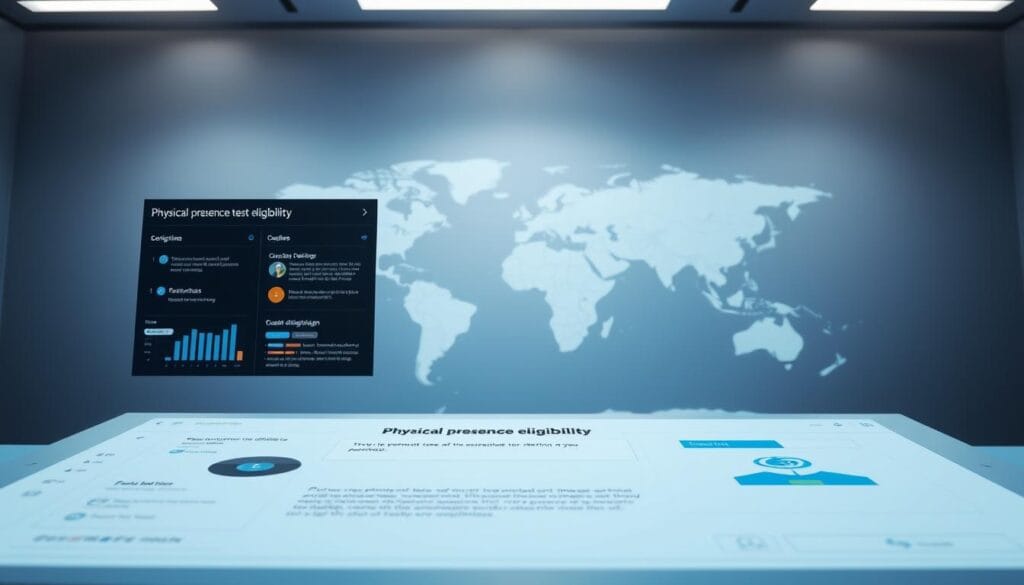Over 3 million Americans living overseas face a startling reality: they remain legally obligated to file U.S. returns, even if their income originates entirely abroad. This citizenship-based system creates unique challenges, requiring meticulous compliance with evolving regulations.
According to Ines Zemelman, founder of Taxes for Expats, modern financial obligations demand adaptive strategies. Traditional methods often struggle to address complexities like foreign-earned income exclusions or reporting requirements for overseas assets. Persistent obligations apply regardless of residency duration, underscoring the need for precise documentation.
Advanced platforms now streamline these processes, automating calculations and ensuring adherence to deadlines. Such tools reduce errors while clarifying eligibility for deductions or treaties. For instance, integrating real-time currency conversion minimizes discrepancies in reporting foreign income.
Professionals recommend leveraging top tax preparation services for 2025 to navigate intricate scenarios. Automated systems flag potential audit triggers, while cloud-based storage centralizes records securely. This approach not only simplifies compliance but also optimizes outcomes for dual-income households or freelancers abroad.
Key Takeaways
- The U.S. enforces citizenship-based taxation, requiring filings even for those residing overseas.
- Foreign income exclusions and asset reporting demand specialized knowledge.
- Modern software reduces errors through automated compliance checks.
- Centralized platforms improve accuracy for multi-currency transactions.
- Timely submissions avoid penalties linked to delayed or incomplete forms.
Introduction: Navigating the New Digital Tax Landscape for Expats

Global mobility reshapes financial responsibilities, with 87% of overseas Americans citing compliance complexity as their top concern. Automated platforms now address this through precision-engineered solutions for cross-border obligations.
Why Modern Platforms Transform Financial Management
Manual preparation of documents like Form 2555 often leads to miscalculations in housing allowances or missed deadlines for FBAR submissions. Specialized systems automate eligibility checks for the Foreign Earned Income Exclusion while synchronizing exchange rates for multi-currency reporting.
“Accuracy in claiming foreign tax credits requires real-time updates on treaty changes – something spreadsheets can’t deliver.”
Balancing Federal and State Obligations
Many overlook lingering state requirements when relocating internationally. Four states actively pursue non-resident filings, creating dual reporting layers. Centralized platforms help track deadlines and document thresholds across jurisdictions.
When selecting solutions, prioritize those offering side-by-side software comparisons to match unique needs. Look for features like audit trail generation and automatic form selection based on residency tests.
Understanding U.S. Tax Obligations for Americans Abroad

U.S. citizenship carries unique financial responsibilities, with worldwide income reporting mandated regardless of residence. Unlike most nations, America enforces citizenship-based taxation, requiring returns even for those earning entirely outside its borders.
Reporting Worldwide Income and Filing Requirements
All American citizens must report global earnings, including salaries, freelance work, or rental income. The Foreign Earned Income Exclusion (FEIE) allows qualifying individuals to exclude up to $120,000 (2025 projected) from taxable income. Eligibility hinges on passing either the Physical Presence Test or Bona Fide Residence Test.
Thresholds for filing remain consistent with domestic rules. Single filers under 65 earning above $13,850 must file, though special rules apply for housing cost exclusions. Self-employed individuals face lower thresholds, needing to report net earnings exceeding $400.
“The FEIE isn’t automatic—it requires precise documentation of physical presence or residency status,” notes Ines Zemelman, founder of Taxes for Expats.
Key considerations include distinguishing between earned income (salaries, business profits) and passive income (investments). While the FEIE applies to earned sources, other exclusions or credits may address remaining liabilities. Dual-income households often combine strategies to maximize savings.
Leveraging Digital Tax Filing for Expats 2025

Eligibility for key financial benefits often hinges on meeting specific residency criteria. Two primary tests govern access to exclusions: the physical presence test and bona fide residence test. These frameworks determine whether individuals qualify for programs like the foreign housing exclusion, which covers certain overseas living expenses.
Eligibility, Benefits, and Key Exclusions
The physical presence test requires spending 330 full days within a 12-month period outside the U.S. Automated platforms simplify tracking by logging travel dates and calculating eligibility windows. By contrast, the bona fide residence test evaluates long-term establishment in a foreign country through employment contracts or residential leases.
Foreign housing exclusions apply differently based on the chosen test. Those qualifying via physical presence can claim allowances proportional to time abroad. Bona fide residents often access higher limits, particularly in high-cost regions. Specialized tools analyze location-specific data to optimize claims.
Comparing the Foreign Earned Income Exclusion and Foreign Tax Credit
Choosing between these strategies depends on income sources and local tax rates. The Foreign Earned Income Exclusion removes eligible earnings from U.S. taxable income, while the Foreign Tax Credit offsets liabilities using payments made to other governments.
“High-tax jurisdictions typically favor credits, whereas moderate-tax areas align better with exclusions,” advises a senior international tax analyst.
Advanced systems compare both approaches in real time, factoring in treaty provisions and withholding rates. This ensures individuals select the most advantageous method while maintaining compliance across jurisdictions.
Essential U.S. Tax Forms Every Expat Should Know

Navigating international financial obligations requires precise documentation. Four forms consistently emerge as critical for compliance: FBAR, Form 2555, Form 1116, and Form 8938. Understanding their distinct purposes prevents costly oversights.
FBAR, Form 2555, Form 1116 and Other Critical Documents
The FBAR (FinCEN Form 114) mandates reporting foreign bank accounts exceeding $10,000 collectively. Failure to file risks penalties up to $14,489 per violation. Form 2555 enables exclusion of foreign-earned income, but strict eligibility rules apply through the Physical Presence Test.
Form 8938 expands on FBAR requirements, targeting specific foreign assets. Individuals with $200,000+ in overseas holdings must file Form 8938 alongside annual returns. Form 1116 addresses foreign tax credits, crucial for avoiding double taxation in high-rate jurisdictions.
How to Report Income from Multiple Sources
Freelancers and investors often juggle diverse revenue streams. Separate schedules clarify earnings from rentals, contracts, or investments. Automated platforms map income types to corresponding forms, reducing manual categorization errors.
“Mixing earned and passive income triggers distinct reporting rules. Cross-referencing Form 2555 with Schedule C prevents misclassification,” advises a certified international tax preparer.
Those managing reporting cryptocurrency holdings face added complexity. Specialized tools now integrate crypto exchanges with traditional income data, streamlining Form 8938 submissions. Always verify filing deadlines—FBAR requires April 15 submission with automatic October extensions.
Mastering the Physical Presence and Bona Fide Residence Tests

Establishing eligibility for international financial benefits requires navigating two distinct pathways. The physical presence test and bona fide residence test serve as gatekeepers for housing exclusions and other advantages. Misunderstanding their requirements remains a leading cause of rejected claims.
Criteria and Time Requirements Explained
The physical presence test mandates 330 full days outside U.S. borders within 12 consecutive months. Partial travel days don’t count—a detail many overlook. Specialized platforms automatically flag border crossings and calculate qualifying periods, reducing manual tracking errors.
By contrast, the bona fide residence test evaluates long-term establishment abroad. Tax authorities assess factors like employment contracts, property leases, and family ties. “Intent to reside indefinitely carries more weight than temporary assignments,” notes an IRS publication.
Best Practices for Proving Residency Abroad
Maintain dated records of housing agreements, utility bills, and local registrations. Digital tools compile these documents into audit-ready portfolios. For housing exclusions, preserve receipts for rent, repairs, and eligible utilities to justify claimed amounts.
Avoid assuming short-term contracts disqualify applicants. Even project-based workers can demonstrate bona fide status through community involvement or repeated renewals. Consistency in documentation proves critical during reviews.
“One client’s rejected claim reversed after submitting three years of gym memberships and voter registrations as residency proof.”
Digital Tools and Software for U.S. Expat Tax Filing

Choosing the right platform simplifies compliance for overseas Americans juggling cross-border obligations. Specialized solutions address unique challenges like multi-currency income streams and residency-based eligibility rules.
Overview of Leading Tax Software Options
MyExpatTaxes leads with tailored workflows for freelancers, offering step-by-step guidance for housing exclusions and self-employment tax calculations. Pricing starts at $199 for basic filings, scaling for complex portfolios. TurboTax’s international edition integrates IRS forms like 2555 and 8938, though lacks dedicated support for digital nomads.
Expatfile targets mid-range users at $149, automating FBAR submissions and foreign tax credit optimizations. H&R Block’s expat service includes unlimited CPA consultations, ideal for first-time filers. All platforms provide audit trails, but response times for specialist queries vary significantly.
Features to Look for in Expat Tax Software
Prioritize tools with real-time treaty updates and multi-jurisdiction compliance checks. Automated currency conversion proves critical for accurate income reporting across borders. Look for platforms that pre-fill recurring data like residency test dates or overseas addresses.
“Software should flag mismatches between FEIE claims and physical presence logs before submission,” advises a certified international tax specialist.
Essential capabilities include mobile-friendly interfaces for remote workers and encrypted document storage. Self-employed users require robust Schedule C integration and quarterly payment estimators. Evaluate free trial periods to test how systems handle unique scenarios like crypto income or rental property deductions.
Optimizing Your Federal and State Tax Return from Abroad

Americans abroad must navigate layered reporting requirements to maintain compliance across jurisdictions. While federal obligations dominate discussions, four states actively enforce non-resident filings. Understanding these dual layers prevents unexpected liabilities.
Steps for Seamless Filing and Maintaining Compliance
Begin by confirming domicile status changes with state authorities. Seven states impose income-based thresholds for non-residents, requiring filings even after relocation. Centralized platforms track residency rules and automate document collection for audit-ready records.
Accurately file taxes by separating income streams subject to state versus federal rules. For example, rental properties in California may trigger obligations despite foreign residency. Use tools that pre-fill recurring data like tax year thresholds or exemption codes.
“Clients often overlook state-specific foreign tax credit limitations, leading to double taxation,” warns a cross-border financial advisor.
Review deadlines meticulously—most states align with federal due dates, but exceptions exist. Virginia requires non-resident submissions by May 1, while Hawaii grants automatic six-month extensions. Integrate deduction optimization strategies during preparation to minimize liabilities across both levels.
Finally, validate all submissions against current tax year regulations. Automated checklists flag mismatches between reported income and supporting documents. This proactive approach reduces audit risks while ensuring timely compliance.
Tax Filing Strategies for Freelancers and Small Business Owners Abroad

Independent professionals working internationally face layered reporting challenges. Juggling client payments, deductible expenses, and cross-border rules demands meticulous organization. Centralized systems now streamline these processes while ensuring adherence to evolving standards.
Best Practices for Maintaining Accurate Records
Freelancers should categorize income streams by jurisdiction and client type. Separate ledgers for earned revenue versus passive sources clarify eligibility for tax credit claims. Cloud-based tools automatically tag transactions, reducing manual entry errors.
Proving bona fide residence status requires consistent documentation. Retain leases, utility bills, and local tax payments to support residency tests. One consultant avoided penalties by presenting three years of bank statements showing primary foreign transactions.
“Track deductible expenses daily—waiting until April leads to missed opportunities. Apps that scan receipts and convert currencies save hours during preparation.”
Regularly reconcile accounts to match tax returns with financial records. Quarterly reviews help identify discrepancies in foreign income reporting. Automated platforms flag mismatches between reported earnings and deposited amounts.
Small businesses benefit from structuring operations around bona fide residence requirements. Aligning contract durations with physical presence thresholds optimizes exclusion claims. Always consult specialists when combining multiple tax credit strategies across jurisdictions.
Guidelines for Self-Employed Expats and Digital Nomads

Remote professionals navigating international borders face intricate reporting obligations. Balancing business income streams with cross-border compliance demands strategic use of tax treaties and precise documentation. These agreements between nations help mitigate double taxation risks—a critical concern for those earning across jurisdictions.
Handling Self-Employment Taxes and Reporting Business Income
Independent workers must report global earnings using Schedule C alongside Form 2555 for exclusions. Over 140 international tax treaties provide frameworks to avoid double taxation, particularly for digital nomads operating under temporary residencies. Proper application requires understanding treaty articles related to business profits and permanent establishment rules.
Foreign bank accounts holding business funds trigger FBAR filings if aggregate balances exceed $10,000. Automated tools track thresholds and generate reports, reducing oversight risks. Experts emphasize that self-employed individuals need file these disclosures even if their primary income originates abroad.
“Mismatched treaty applications account for 22% of amended returns among overseas entrepreneurs. Cross-referencing IRS guidelines with host country laws prevents costly errors,” advises Ines Zemelman, Taxes for Expats founder.
Quarterly estimated payments often apply to freelancers, requiring currency-adjusted calculations. Centralized platforms simplify this by converting earnings and projecting liabilities in real time. Those who need file multiple state returns should prioritize software with multi-jurisdiction compliance checks.
Strategies to Manage Late Filing, Amendments, and IRS Penalties

Nearly 30% of overseas Americans miss initial deadlines due to time zone confusion or delayed documentation. Proactive planning minimizes penalties while preserving compliance. Modern systems automate extension requests and streamline amendment processes, turning potential crises into manageable tasks.
Understanding Automatic Extensions and Penalty Relief Options
Automatic six-month extensions apply to federal returns by filing Form 4868. This postpones submission deadlines to October 15 without requiring explanations. However, estimated payments remain due by April 15 to avoid interest charges.
Those residing in a foreign country qualify for additional two-month extensions under specific conditions. Special relief programs like the Streamlined Filing Compliance Procedures waive penalties for unintentional delays. Eligibility requires proving non-willful neglect through three years of amended returns and six years of FBARs.
“Submitting Form 114 late triggers penalties up to 50% of account balances. Timely corrections through amended filings demonstrate good faith,” advises Ines Zemelman of Taxes for Expats.
Amendments via Form 1040-X require meticulous documentation of changes. Highlight adjustments in income tax calculations or foreign bank disclosures. Centralized platforms track modification impacts across all related forms, including Form 8938 and Schedule B.
For complex cases, the IRS’s Voluntary Disclosure Program offers reduced penalties. Always consult specialists before initiating disclosures involving multiple foreign bank accounts or unresolved liabilities.
Insights and Recommendations from Tax Experts
Managing overseas financial responsibilities often hinges on expert strategies tailored to unique living conditions. Professionals emphasize meticulous documentation, particularly for foreign housing costs, which frequently trigger audit scrutiny if improperly reported. Accredited specialists like Ines Zemelman highlight three core principles: clarity in expense categorization, proactive treaty application, and strategic exclusion stacking.
Expert Tips for Simplifying Complex Tax Situations
Track every housing-related payment—from rent to utility deposits—using location-stamped digital receipts. This granularity strengthens exclusion claims during reviews. One consultant reduced client liabilities by 18% through optimized foreign housing allowance calculations paired with capital gains planning.
Limit common errors like conflating temporary accommodations with permanent residence costs. “Lease agreements must align with physical presence periods to avoid clawbacks,” Zemelman advises. Automated tools now cross-reference travel logs with housing invoices, flagging mismatches instantly.
Real-Life Experiences from U.S. Expats
A freelancer in Tokyo maximized exclusions by separating urban rent from rural workspace costs—a move validated during an IRS inquiry. Another household combined treaty benefits with foreign housing deductions, cutting annual liabilities by $9,200 despite dual-income streams.
“Clients often overlook ceiling limits based on location. High-cost cities like Zurich permit higher exclusions than regional towns—details matter.”
These cases underscore the value of scenario-specific planning. While standardized software handles routine filings, complex foreign housing scenarios demand professional insights to navigate overlapping regulations and maximize savings.
Emerging Trends and Future Outlook for Expat Taxation
Technological advancements are reshaping how global citizens manage cross-border obligations. Automated systems now predict compliance gaps by analyzing residency patterns and income streams across multiple jurisdictions. This shift enables proactive planning rather than reactive corrections.
How Innovation Streamlines Financial Compliance
Real-time data synchronization across platforms helps maximize tax benefits throughout the calendar year. New tools track treaty updates and eligibility changes, alerting users to optimization opportunities. One platform reduced paperwork errors by 63% through AI-driven form validation.
Emerging systems integrate biometric verification for secure document submissions. Blockchain-based recordkeeping gains traction, creating immutable audit trails for foreign assets. These developments simplify proving residency status during reviews.
“Future compliance hinges on systems that learn from user behavior to anticipate reporting needs.”
Enhanced tax benefits emerge as governments recognize remote work trends. Analysts predict expanded exclusions for hybrid workers splitting time between countries. Automated calculators will adjust claims based on daily location logs.
Tracking obligations across the calendar year becomes seamless with predictive analytics. Software now flags quarterly payment deadlines and treaty expiration dates. This continuous monitoring helps avoid last-minute scrambles before annual submissions.
International agreements increasingly standardize digital reporting formats. Such harmonization reduces duplication when claiming tax benefits across multiple regions. Machine translation features help navigate foreign-language forms accurately.
Looking ahead, voice-activated assistants may guide users through complex scenarios. These innovations promise to make compliance feel less like an annual chore and more like integrated financial management. Strategic use of tax benefits will increasingly separate optimal outcomes from missed opportunities.
Conclusion
Navigating financial responsibilities across borders demands precision and modern solutions. Automated systems transform how global citizens manage obligations, turning complex regulations into streamlined workflows. Strategic planning remains essential—particularly when balancing multiple jurisdictions or handling real estate holdings abroad.
Effective compliance hinges on understanding evolving requirements. Centralized platforms help track deadlines while optimizing claims for foreign income exclusions. Proper documentation of taxes paid to other governments prevents costly disputes and maximizes credit opportunities.
Even intricate scenarios like overseas property investments become manageable with proactive preparation. Regular reviews of residency status and income sources ensure alignment with current rules. Those who prioritize timely taxes paid submissions avoid penalties while maintaining financial flexibility.
Looking ahead, continuous innovation will further simplify cross-border obligations. Professionals should explore tools offering real-time updates on treaty changes and real estate reporting standards. Mastery of these resources empowers individuals to focus less on paperwork and more on thriving internationally.

